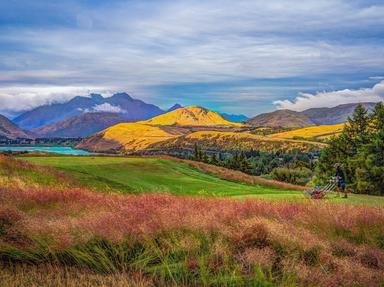Quiz Answer Key and Fun Facts
1. In 1642, Dutch explorer Abel Tasman's ships, the Heemskerck and the Zeehaen, dropped anchor in this bay located at 40deg 50' S, 191deg 30' E. The local Maori were distinctly unfriendly, and killed four sailors who were transferring between the two ships in a pinnace. Tasman called the place where the murders occurred Murderers Bay, naturally enough. What is it known as today?
2. The Maori name for the South Island is Te Wai Pounamu. What does this mean?
3. Travelling south from Blenheim, not long after the road reaches the east coast of the South Island you come across a bay where salt is being extracted by evaporation. This is the Lake Grasmere salt works. The town you have just passed through is the service centre for Lake Grassmere as well as for the surrounding farming community. What is the town called?
4. A pass through the Southern Alps was named after the Canterbury provincial geologist who may or may not have been the first person to traverse this gap in the mountains. What was the name of the surveyor?
5. What form of nineteenth century transport had been reinstated in Christchurch in recent years?
6. Julius von Haast named the second-highest peak in New Zealand, which is in the Southern Alps. What is its name?
7. A large, elevated, and rather ill-defined inland area of South Canterbury is named after a rather famous shepherd and sheep-thief of the nineteenth century. What is the name of the area?
8. Haast again. Julius von Haast named the Haast River after himself. The name applies to the river all the way to the sea at - where else? - Haast on the West Coast. But, based on water volume, the Haast River is actually only a tributary of the much larger river into which it flows and which drains the back of the Southern Alps near Mt Cook. The name of this river is also the name of a town 80km north of Brisbane in Australia and is named after the same person. What is the river called?
9. Lake Wanaka was the place that many people from Canterbury and Otago used to buy their holiday homes. However, the increase in real estate values at Wanaka forced locals to look further afield. What is the name of the next lake to the north-east which became a popular holiday resort as a result?
10. Queenstown, the adventure tourism centre, was named at a town meeting in a pub one Sunday afternoon.
11. The Manapouri hydroelectric scheme was built specifically to supply large amounts of electricity to one of New Zealand's heavy industries. Which industry is it?
12. This New Zealand native bird was thought to be extinct for many years, but an Invercargill ornithologist, G.B. Orbell, discovered a colony of them living in the subalpine scrub in the Murchison Mountains beside Lake Te Anau. Since then, a breeding programne has been steadily increasing the numbers of these birds, although they are still very endangered. What kind of bird is it?
13. "Skippers Canyon" is an extremely popular and well-known tourist destination in the environs of Queenstown. It is located on a large sheep station which shares the name of the mountain of which Skippers Creek drains the eastern side. What is the name of the sheep station and mountain? Think "gold".
14. The first two ships bringing immigrants to the Otago Settlement - Dunedin - were the John Wickliffe and the Philip Laing. They arrived in April, but in what year?
15. Foveaux Strait is the source of a seafood delicacy which fetches extremely high prices both in New Zealand and overseas. What is it?
Source: Author
Capfka
This quiz was reviewed by FunTrivia editor
Exit10 before going online.
Any errors found in FunTrivia content are routinely corrected through our feedback system.
